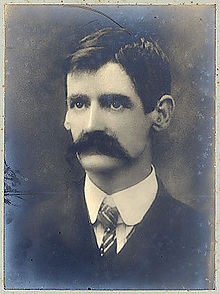Henry Lawson

Henry Lawson (17 June, 1867 - 2 September, 1922) was an Australian writer and poet. Along with his contemporary Banjo Paterson, Lawson is among the best-known Australian poets and fiction writers of the colonial period.
Career
Early life
Lawson was born on the Grenfell goldfields of New South Wales. His mother was Louisa Lawson, a prominent suffragist and owner/editor of The Dawn journal which was partly responsible for Australia becoming one of the first countries to introduce adult female suffrage. His father was Niels Larsen, a Norwegian seaman who settled in Australia; on Henry's birth, the family surname was anglicised and Niels became Peter Lawson. Henry suffered an ear infection at the age of nine that left him with partial deafness and by the age of fourteen he had lost his hearing entirely.
Most of his work focuses on the Australian bush, such as the desolate Past Carin’, and is considered by some to be among the first accurate descriptions of Australian life as it was at the time.[citation needed] Lawson was a firm believer in the merits of the sketch story, commonly known simply as 'the sketch,' claiming that "the sketch story is best of all."[1] Lawson's Jack Mitchell story, On The Edge Of A Plain, is often cited as one of the most accomplished examples of the sketch.[2]
Like the majority of Australians, Lawson lived in a city and had plenty of experience in outback life, in fact, many of his stories reflected his experiences in real life. In Sydney in 1898 he was a prominent member of the Dawn and Dusk Club, a bohemian club of writer friends who met for drinks and conversation. He married Bertha Bredt Jr., daughter of Bertha Bredt, the prominent feminist and socialist.
Later years
During his later life, the alcohol-addicted writer was probably Australia's best-known celebrity. At the same time, he was also a frequent beggar on the streets of Sydney, notably at the Circular Quay ferry turnstiles. He was gaoled at Darlinghurst Gaol for drunkenness and non-payment of alimony, and recorded his experience in the haunting poem "One Hundred and Three" - his prison number - which was published in 1908. He refers to the prison as "Starvinghurst Gaol" because of the meagre rations given to the inmates.
On his death in Sydney in 1922 he was given a state funeral, attended by the Prime Minister W. M. Hughes and the Premier of New South Wales Jack Lang (who was the husband of Lawson's sister-in-law Hilda Bredt), as well as thousands of citizens. He is interred at Waverley Cemetery.
Henry Lawson was featured on the former paper Australian ten dollar note issued in 1966 when decimal currency was first introduced into Australia. This note was replaced by polymer notes in 1993. Lawson was pictured against scenes from the town of Gulgong in New South Wales.[1]
Collections of Poetry and Prose
- While the Billy Boils (1896)
- On the Track (1900)
- Over The Sliprails (1900)
- The Country I Come From (1901)
- In the Days When the World was Wide and Other Verses
- Joe Wilson and His Mates (1901)
- Verses: Popular and Humorous
- The Romance of the Swag (1907)
- Send Round the Hat (1907)
- The Rising Of The Court, and Other Sketches in Prose and Verse (1910)
- Triangles of Life and Other Stories (1913)
- Children of the Bush
Popular Poems, Short Stories and Sketches
- "Andy's Gone with Cattle" (poem)
- "Freedom on the Wallaby" (poem, 1891)
- "Saint Peter" (poem, 1893)
- "Scots of the Riverina" (poem, 1917)
- "The Teams" (poem, 1896)
- "Up The Country" (poem, 1892)
- "The Drover's Wife" (short story, 1892)
- "The Bush Undertaker" (short story, 1892)
- "The Loaded Dog" (short story, 1901)
- "The Iron-Bark Chip" (short story,1900)
- "Steelman's Pupil" (short story)
- "The Geological Spieler" (short story, 1896)
- "A Child in the Dark, and a Foreign Father" (short story, 1902)
- "The Union Buries Its Dead" (short story, 1893)
- "A Neglected History" (essay)
- "Australian Loyalty" (essay, 1887)
- "United Division" (essay, 1888)
Recurring Characters
- Dave Regan, Jim Bently and/or Andy Page
Recurring Themes of Lawson's Stories
Many of Henry Lawson's short stories explore similar themes:
- Roles of women
- Roles of men
- Roles of children
- Loneliness / Isolation
- Hardship
- Importance of Humour
- The Emotional Impact of Bush Life
- Mateship
References
Australian Dictionary of Biography. Canberra: National Centre of Biography, Australian National University. ISBN 978-0-522-84459-7. ISSN 1833-7538. OCLC 70677943 http://www.adb.online.anu.edu.au/biogs/{{{id}}}.htm. {{cite encyclopedia}}: External link in |Link=|title= (help); Unknown parameter |First= ignored (|first= suggested) (help); Unknown parameter |Last= ignored (|last= suggested) (help)
